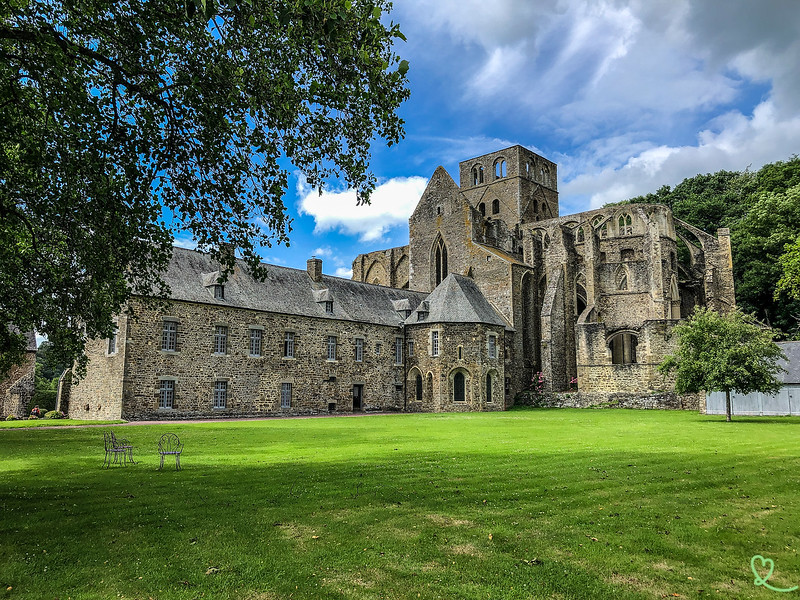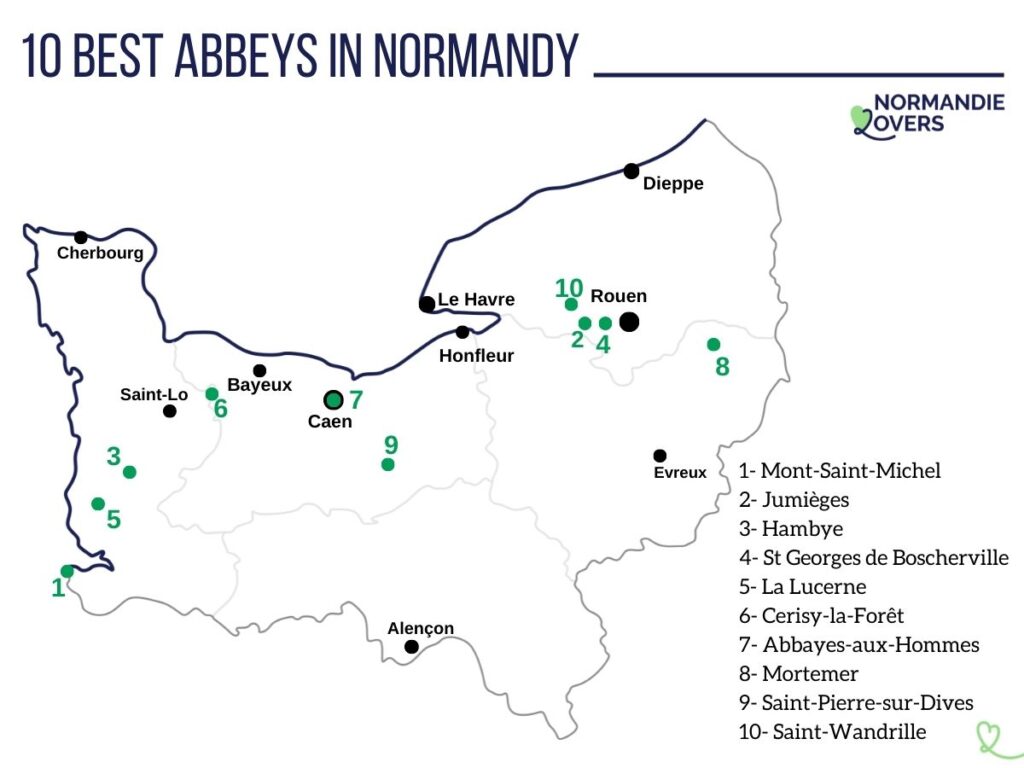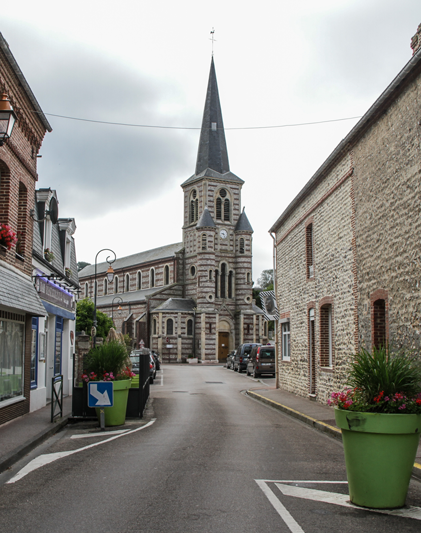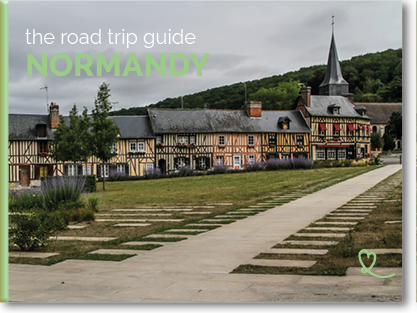Hambye Abbey is a true medieval gem in Normandy, with its majestic ruins, preserved monastic buildings and a fine collection of Hambye canvases, a unique folk art. We loved the peaceful atmosphere of this historic site.
In this article, you’ll find our photos and tips for making the most of your visit toHambye Abbey.

This guide is completely independent, based on our experiences. We visited the region anonymously, making our own choices and paying our bills in full.
Why visit Hambye Abbey?
Is the abbey worth it? Our opinion:
Absolutely! As well as the impressive ruins of the church, the visit is really interesting because it’s a complete complex with the chapter house and living quarters, including farm buildings. We really enjoyed the romanticatmosphere of the abbey church, as well as that of the parlor with the flowers painted on its vaulted ceiling. In our opinion, it’s one of the most beautiful abbeys in Normandy.

Why is Hambye Abbey famous?
The abbey is famous for the ruins of its abbey church, cloister and chapter house, which are outstanding examples ofNorman Gothic architecture. We were pleasantly surprised by the historical richness of the site and the remarkable preservation of the buildings. The restoration work carried out since 1956 has enhanced this unique heritage.

Our favorite moments
- Theabbey church with its imposing ruins
- The chapter house, a jewel of Norman Gothic architecture
- The parlor ceiling adorned with painted flowers

History in brief
The history of Hambye Abbey is full of twists and turns. Here’s what we’ve learned:
- 1145: Abbey founded by Guillaume Painel, Lord of Hambye
- 15th century (Hundred Years War): Decline of the monastic community
- 1780: Extinction of the community. Emptied of its inhabitants, the abbey was gradually turned into a quarry and fell into disrepair.
- 1902: Listed as a Historic Monument
- 1956 and 1964: Successive acquisitions by the Beck family and the Département de la Manche, and start of restoration work.

Access and map: Hambye Abbey in Normandy
Where is the Abbey?
- In the village of Hambye, Normandy
- Driving time from Saint-Lô: 35min
- Driving time from Granville: 40min
- Driving time from Caen: 1h
- Here’s a map of Normandy abbeys to help you locate Hambye:

How to get there?
The most practical way to make the most of your visit is by car.
Access by public transport is limited. The nearest station is Villedieu-les-Poêles-Rouffigny (Paris-Granville line), 12km from the abbey.

OUR ADVICE FOR RENTING A CAR IN Normandy
- Compare prices on our preferred platform: DiscoverCars – one of the best rated sites.
- Choose a car that is comfortable enough (distances can be long) but compact (some parking lots and villages are narrow).
- Think of thecomplete insurance (some roads are tortuous and narrow).
- There is a lot of demand, book it early.

Parking
Free parking is available, shared with the Auberge de l’Abbaye restaurant.
Useful tips: duration, schedules, eating…
Best time to visit
We recommend a visit between April and June, or in September, to enjoy the site in complete tranquillity. In July and August, opening hours are longer, but also attract more visitors. Better to come as soon as it opens.

Length of visit and main difficulties
- Allow around 1 hour to explore the entire site.
- Gravel driveways can make progress more difficult for strollers with small wheels.
- We noted the presence of stairs in some parts of the site, but ramps make it easier to visit certain rooms.

Advice on how to visit
- For the best possible visit, we recommend you pick up a visitor’s guide at reception.
- On our visit, we first explored the remains of the abbey church, before discovering the monastic buildings and enjoying the gardens. We finished our visit with the exhibition devoted to the Hambye canvases.

USE OUR GUIDE TO PLAN A
DREAM TRIP TO Normandy
All the information you need for your trip:
- 8 maps that make planning easier
- 160+ pre-selected locations
- Practical advice
- 300+ photos to help you choose

Visiting with children
While the abbey offers a wide range of activities for school groups, we didn’t see any dedicated children’s activities for individual visits.

Schedules and rates
The abbey is open:
- April to June and September: 10am to 12pm and 2pm to 6pm
- July and August: 10 a.m. to 6 p.m.
- During the autumn vacations: 10am to 12pm and 2pm to 5:30pm
- The site is closed on Tuesdays except in July and August, and on May 1st.
Admission is €6. Find out more here.

Guided tours
- Guided tours take place daily at 11am, 2.30pm and 4.30pm from April to September, and at 11am and 3pm during the autumn vacations.
- Each tour lasts 1h15 and covers the history of the site from its foundation to recent restorations.
- A supplement of €2 is charged on top of the entrance fee.

Catering
- There’s a picnic area on site.
- L’Auberge de l’Abbaye, just next door, offers gourmet cuisine featuring local produce.

Subscribe to our Newsletter
- Get away from it all with Region Lovers’ beautiful destinations!
- Once a month
- Advertising-free
Discovering monastic buildings
The entrance porch
The porter’s house is the abbey’smain entrance. It’s an essential point of passage that opens onto the first courtyard, the hub of the abbey’s large-scale farming operation. We noticed the well-preserved architecture of this building, once used as a control point for comings and goings between the outside world and the monastery’s sacred space.

Remains of the medieval cloister
The cloister was dismantled in the 19th century. Nevertheless, we enjoyed imagining it, observing the preserved remains and, in particular, the geometry of the garden. In fact, it’s possible to make out thefootprint of this essential meditation space and passageway between the various monastic buildings.

The chapter house, the heart of the community
We loved the elegant vaults of the chapter house. They rest on slender columns that testify to exceptional architectural mastery. A tour of this room reveals its importance in the lives of the monks. They met there every day to discuss community affairs. It was here that important decisions were taken and monastic rules handed down.

The kitchen with its monumental fireplace
The abbey’s kitchen took us into the monks’ daily lives. We were impressed by its monumental fireplace, which takes up an entire wall. Its low-arched lintel measures 3.90 metres wide! The size of this room and its furnishings reflect the importance attached to the organization of daily life.

Farm buildings
Here we discovered a collection of old tools and an impressive apple press. All these objects evoke the various activities of the abbey’s occupants. They contributed to the religious community’sself-sufficiency.

Explore the ruins of the abbey church
The imposing remains of the tower
The ruins of the abbey church still bear witness to the great architectural ambitions of the Hambye monastic community. We were struck by the majesty of these remains, which oscillate between Romanesque and Gothic styles. The choir’s columns are reminiscent of those of Coutances Cathedral, suggesting the church’s former splendor.

Raising the choir
The elevation of the choir is a remarkable example of medieval religious architecture. We were captivated by its three-level composition: the large arcades at the base, followed by an intermediate level pierced by small windows, and finally the tall, three-lobed windows. Restoration work carried out in 2009 and 2010 has preserved this unique structure, giving us the opportunity to admire the architectural genius of medieval builders.

The Hambye canvases
A collection on permanent display
The permanent exhibition of Hambye canvases shows how a family oflocal craftsmen developed a distinctive artistic style. They created pieces that are now considered real treasures of the region’s heritage. We were able to admire the richness of the motifs and understand the importance of these paintings in the lives of the people of the time.

A folk art rich in history
His richly patterned canvases were produced in the first half of the 19th century. They reflect the traditions and popular culture of rural Normandy. They once decorated the walls of alcove beds. These remarkable pieces tell the story of local craftsmen and reveal a great deal about the way of life in those days.

Frequently asked questions
What else can you do in Hambye?
We were able to observe the many marked hiking trails around the abbey. A river discovery trail (the abbey is located very close to the Sienne) particularly caught our attention. It starts at the parking lot and details the challenges facing this wetland. Find out more here.

PLAN YOUR TRIP TO Normandy
Inspiration destinations
- Deciding where to go in Normandy – the best destinations
- Our weekend ideas: best-of, romantic, unusual, seaside, luxury, family
- 16 seaside hotels in Normandy
- The most beautiful charming hotels in Normandy

Best of

Practice
- Where to stay in Normandy – best places and hotels
- See our tips for renting a car at CDG airport, Orly airport, Beauvais airport, Caen, Rouen, Bayeux…






